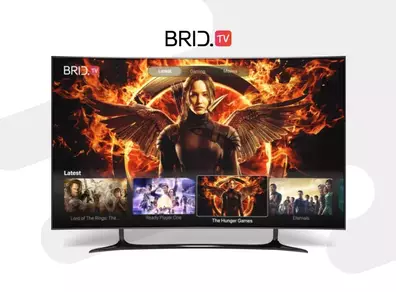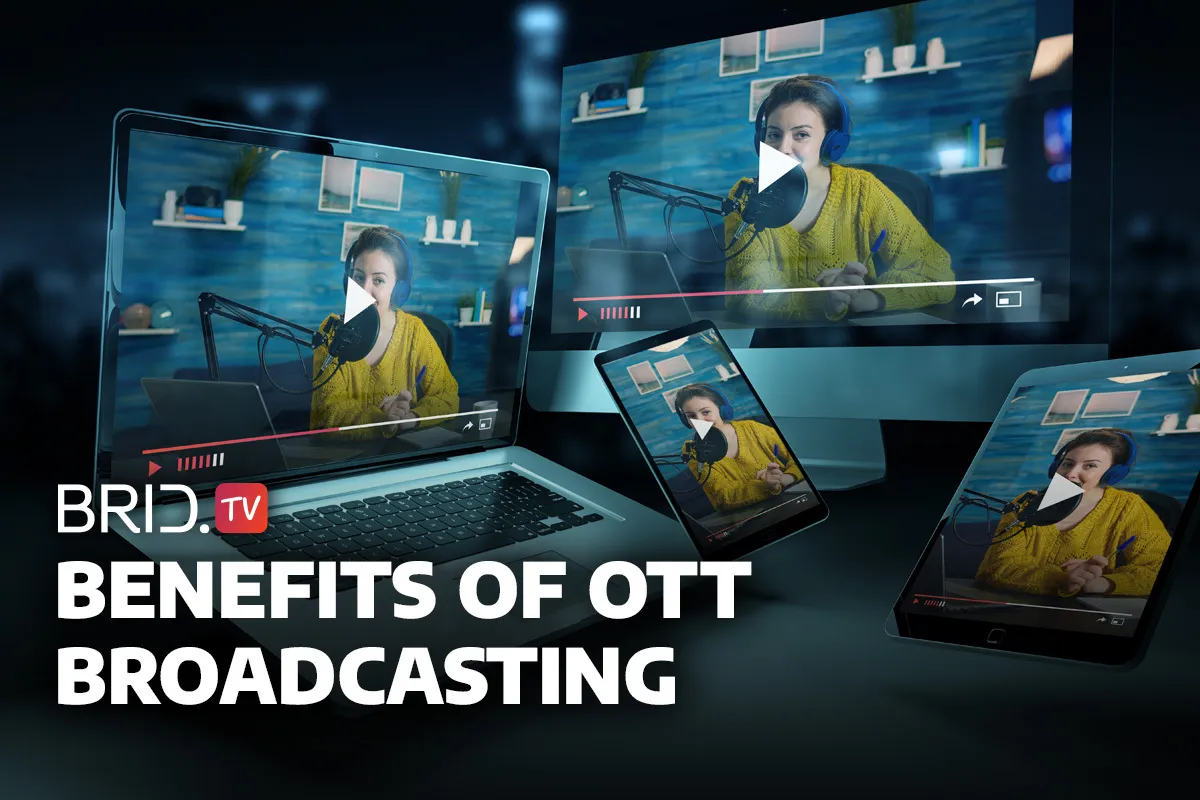OTT broadcasting is taking over the internet. Whether you want to watch an episode of your favorite show, tonight’s baseball game, or a coding course, the chances are you will do so using an OTT app or website. For content creators and video publishers looking to make the most out of OTT streaming, understanding exactly what it is and how it works is crucial for a successful business. Let’s take a closer look at the behind-the-scenes processes of OTT broadcasting and what benefits it brings video publishers.
What Is OTT Broadcasting?
OTT, or over-the-top, refers to any streaming service delivered over the internet, rather than old-school cable or satellite networks. It allows viewers to access the content they want using OTT streaming services on their computers, phones, smart TVs, or any other OTT device of their choosing. OTT broadcasting, sometimes also referred to as OTT streaming, is the process of delivering video content to viewers.
How Does OTT Broadcasting Work?
For viewers, the process of OTT broadcasting seems quite straightforward — they log into their favorite OTT app, choose a show, movie, live stream, or another piece of content they want to watch, and enjoy the show. However, there is much more than that going on behind the scenes.
OTT libraries work using the support of OVPs — online video platforms (also sometimes called OTT platforms). These platforms are responsible for the behind-the-scenes processes, such as hosting content, delivering it to the viewer, monetizing videos, and more.
When a viewer accesses the library and chooses the content they want to view, the OVP initiates an automated process that analyzes the streaming capabilities of the viewer. This includes the operating system the library is being accessed through, the type of internet connection, and the bandwidth. This information tells the OVP how to play the video — that is, in what format and resolution.
Since video files tend to be quite large, they need to be broken down into so-called packets to ensure a smooth viewing experience. These packets are sent to the viewer’s device one at a time and then reassembled into a whole video again. This process allows for the implementation of adaptive bitrate streaming — the process of adjusting video quality to fit the viewer’s streaming capabilities in real time.

Types of OTT Streaming
Although OTT streaming is a broad term, it can be divided into two main categories — OTT video on demand and OTT live streaming. Let’s take a closer look at their main characteristics and the differences between them.
Video on Demand (VOD)
VOD, or video-on-demand, is a service that allows consumers to view content on their own time from wherever they want. Some of the most popular OTT apps that offer VOD are Netflix, Hulu, and Disney+.
The biggest advantage of video on demand is that viewers don’t have to follow a broadcasting network’s predetermined schedule, nor do they have to sit at home in front of a TV. In addition to this, there is less equipment involved — all a viewer needs is an OTT-compatible device. But even if the device used to access VOD content does not support OTT, such as a non-smart TV, an OTT box can make VOD accessible and turn any old television set into an OTT TV.
On top of cable TV, OTT VOD also stands in stark contrast to IPTV, which requires a set-top box, a router, and a private network, usually making access limited to the household.
Live Streaming
Unlike VOD, live streaming does not offer time flexibility, as live streams are viewed in real-time. Due to the immediacy of the stream, the process that goes on behind the scenes is more complicated. In other words, it necessitates both additional hardware and software. For example, it needs an OVP that supports live streams — also known as a live streaming platform. Also, the packets that the stream is broken into are much smaller in this scenario.
However, live streaming has an upper hand in terms of user engagement. Many video streaming platforms and players also include additional options, such as chats (although these are still not an option in OTT live streaming). Viewers can use these to comment on the content, interact with one another, or ask the streamer a question. Another element that many platforms incorporate is a donation button, which is one of several ways to monetize live streams. But more on that in a bit.
Although live streaming and video-on-demand are two very different processes, they are not necessarily mutually exclusive. Some content creators who mostly rely on live streaming also make their content accessible after the live stream is over. In this way, they combine the two and potentially broaden their viewer base significantly.

Differences Between VOD and Live Streaming
As you can see, VOD and live streaming are very different methods of video content delivery. Here’s a quick overview of the major distinctions between the two:
VOD:
- Watch content whenever you want
- Higher-quality content thanks to post-production
- Great for shows, movies, video courses
Live Streaming:
- Watch content in near real-time
- More user engagement
- Great for conferences and events such as sports games and concerts
Why Publishers Should Care About OTT — Benefits of OTT for Publishers
So why should you, a publisher, care about OTT? In short, OTT allows you to reach wider audiences and generate more revenue.
Statistics show that the number of OTT users has been growing and is expected to reach 3.5 billion by 2027. That large of an audience opens doors to OTT marketing opportunities as we have never seen before. Whether you want to adopt the AVOD model for OTT monetization and serve video ads to your viewers, or you would rather try out some other video monetization model, options are plentiful.
If you want to include OTT advertising in your revenue sources, you can do so with TargetVideo and without much hassle. Similarly, you can minimize expected losses to ad errors using analytics and hands-on support created to help you optimize your ad stack. Server-side ad insertion will take care of that. Also known as ad stitching, this insertion technique stitches instream video ads into the content that’s being streamed, minimizing the strain on your website.
Overall, with OTT broadcasting, you can:
- Reach a wider audience of people interested in your content;
- Monetize your content in a number of ways, from ads to subscriptions;
- More easily target the right audience with the right content and ads;
- Enjoy a more stable revenue stream without depending on other platforms’ advertising standards;
- Have access to user insights and analytics to help you develop your business.
How Publishers Can Enter the OTT Market
Understanding all the benefits of OTT for your content publishing business is the easy part. Real work starts with creating an OTT app. There are several ways you can do this.
First, you can create an app yourself. However, this will require some app-building and app-managing knowledge (or time to gain that knowledge). While it may save you some money, DIY-ing it would be time-consuming, difficult, and risky.
Another option is to hire a developer to do it for you. This will allow you to launch an app with minimal effort and in a much shorter period of time. However, be prepared to part with tens of thousands of dollars for a good, user-friendly app.
Lastly, you can turn to an OTT platform and lease an app for a fixed monthly fee. Although you won’t have a say in the development of the app from scratch, a good service provider will still ensure you have access to significant customization options. What’s more, with this option, you will also get video hosting services, app maintenance, technical support, various monetization options, and more.
Launch and Monetize an OTT App With TargetVideo
With the TargetVideo platform, you can launch an OTT app without much fuss and customize it to fit your idea. Using TargetVideo SDK, you can create apps for Apple TV, Roku, Amazon Fire TV, Android TV, iOS, Android, and more. Take advantage of our customizable HTML5 player, DRM protection technology, and video content management platform to launch your OTT business.
Monetizing your OTT app and managing your ad inventory will also be a breeze with TargetVideo. Our player SDK supports a wide array of video ad formats and yield optimization tools to maximize your ad revenue. Our player supports both VAST and VPAID ad templates, which work great with OTT apps on all devices.
Launching a branded OTT app has never been easier. Reach out to TargetVideo to find out how we can help!

